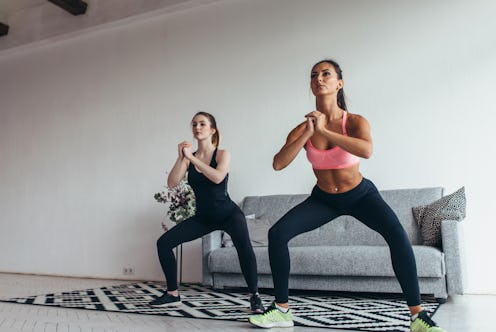Fitness
Sumo Squats Are The Functional Glute Exercise You Should Be Doing
Get low.

You’d be hard-pressed to find a workout routine that doesn’t include a squat. This lower leg exercise is a go-to for stronger quads, calves, hamstrings, and glutes. Take a wider stance, though, and you can turn a simple squat into a sumo squat. It’s a small change, sure, but it makes a big difference in what you get out of the move.
Unlike regular squats that keep your feet and knees parallel, a sumo squat is a variation that focuses on a wide stance with out-turned feet, says Chloe Woo, CPT, a certified personal trainer at Dogpound West Hollywood. With that slight difference in your foot position, Woo notes that you’ll work your muscles in a different way.
“Sumo squats are a great lower body strength movement and really help to activate your adductor muscles, aka those tricky inner thighs,” Woo tells Bustle. The wide stance of the exercise also engages your glute muscles from a different angle and it even activates your core, adds Eiryn Hernandez, a master trainer and founder of Toned w. Eiryn. And, much like regular squats, the experts note that doing the lower body move strengthens the muscles you use when walking, running, jumping, and going up and down stairs — making it a functional exercise.
This move will improve your hip mobility, too, says John Gardner, a certified personal trainer and co-founder of Kickoff. “The hip joints are one of the tightest spots that require a lot of exercises to reduce the tension,” he tells Bustle. “Sumo squats activate the joint and work as a stretch, as the stance spreads your legs in a wider stance and improves hip mobility in the process.” Here’s how to give the multi-beneficial exercise a try.
How To Do A Sumo Squat
Here, Woo explains how to set up for a proper sumo squat.
- Step your feet shoulder-width apart or slightly wider.
- Point your toes out 45 degrees with your heels pointing back towards your body.
- Keep your weight in your heels as you send your butt back and bend your knees.
- Lower into a squat.
- Make sure your knees stay wide the entire time.
- Keep your knees behind your toes and point them out in the same direction as your feet.
- Stand back up and squeeze your glutes at the top of the movement.
- Lower back down and repeat.
- Aim for 2 to 3 sets of 10 to 20 reps.
How To Modify A Sumo Squat
Once you get the hang of how to do a sumo squat with good form, feel free to up the challenge even more with various add-ons. “Sumo squats can be done at a slower tempo,” Woo says, to really bring on that burn. You can also add a resistance band above your knees or hold weights like dumbbells, kettlebells, or a barbell to increase your squat load. Pro tip? According to Hernandez, holding a heavy dumbbell straight in front of you while squatting can indicate how deep you can go. “If the dumbbell doesn't touch the floor then I know my range of motion on my hips is limited and I need to work on that area,” she shares.
If your hips are tight or you want to make this squat a little easier, Hernandez recommends holding onto a pole to help you keep good form. “You can also start with regular squats,” she says. “Once you feel good about doing those, you can move to different squat variations like these sumos.”
Common Mistakes To Avoid
Pay attention as you lower down into the squat. According to Woo, it’s common for the knees to buckle or rotate inward, which tends to happen when your hips are tight. “Keeping the knees in a solid line and stacked over the ankles is key, as this causes the weight distribution to stay in the heels,” she says.
As you raise back up, keep an eye on your hips. “Be cautious that your hips don’t shoot up first when standing from the squat,” Hernandez explains. “Be sure to drive through your feet to recruit the glute and quads.”
It’s also key to keep your back straight instead of arched. “Strengthening the core will help to ensure that the back doesn’t overcompensate,” says Woo. “Focusing on a neutral spine and working on form before adding weight will help you avoid injury.”
Studies referenced:
Coratella, G. 2021. The Activation of Gluteal, Thigh, and Lower Back Muscles in Different Squat Variations Performed by Competitive Bodybuilders: Implications for Resistance Training. Int J Environ Res Public Health. doi: 10.3390/ijerph18020772.
Sources:
Chloe Woo, CPT, certified personal trainer at DOGPOUND West Hollywood
Eiryn Hernandez, master trainer, founder of Toned w. Eiryn
John Gardner, certified personal trainer, co-founder of Kickoff
This article was originally published on